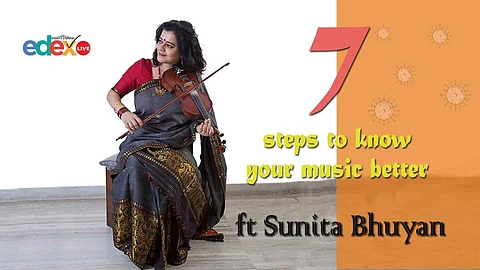

For every situation, we have music that can save us, give us hope and make us feel alive. We saw numerous videos coming in from Italy showing people from the city of Naples singing Bella Ciao, an Italian Resistance song, from their balconies as the Coronavirus continued to tighten its grip. Similarly, Indo-fusion violinist Sunita Bhuyan has been spending her lockdown time being a part of balcony concerts, online concerts, playing along with her son who plays the piano. She tells us how music has kept her and her family going in these distressing times.
She explains that taste and exposure are important factors determining what kind of music you would like to listen to. However, in such difficult times, everyone could do with a little bit of music in their lives to uplift them. Sunita explains to us in detail what kind of music will suit and uplift our different modes — study, work, cook, during yoga and all the other modes that we go through in a day.
May music soothe your soul!
1. Study mode: If a student is exposed to Indian classical music, they would have better facilitation of the brain cells if they listen to it while they are trying to concentrate. Music is a very relatable craft, the mind and body have the cognizance of accepting it. Classical bandishes that they have been exposed to would be good to listen to. If they are used to listening to Western classical like Bach and Beethoven, then that will help them concentrate. Generally, country music, Western classical fusion, instrumental are what students should listen to while studying.
2. Work mode: If an adult is working on the laptop, you want facilitative music but not something that will distract you. You are not partying. One has to hear something that will calm the nervous system, facilitate their brain cells for them to be more productive. The calmer we become, the more we can concentrate on our work. Ghazals, Western classical symphonies, classical vocal are typically the kind of music that helps.
3. Chores mode: While doing mundane tasks, one should hear all their favourite, fun songs meaning all the funky Bollywood numbers. You want songs that you can sing along, you need participative songs while doing these activities. Rhythm is extremely important in times like these. These songs will uplift your mood and take away the boredom of household chores.
4. Yoga mode: The songs you will listen to while performing yoga are quite different from the ones that we listen to while at the gym or doing heavier exercises. Yoga demands soft, slow music like aalaps. It needs to follow a slower rhythm pattern for you to slow your thoughts and only then will it have a huge therapeutic effect on your body and mind.
5. Walk mode: While walking even inside the house you need to follow a rhythm. However, it should not be too loud that as it can affect your eardrums and also distract you. Upbeat tracks, country music are the kinds one can listen to.
6. Eat mode: Faster Western classical, party songs, Mozart symphonies, uplifting folk music are suggested while you are at it. Some people prefer to converse while at the dining table but for some, it might be more soothing to listen to music especially if they stay alone.
7. Sleep mode: At the end of a tiring day, calming music is what everyone needs to help them fall asleep. Music helps them drive away all the tension, stress and calms the mind and the body to be in a complete form of rest. Ghazals, khayal, Indian classical, soft instrumental are what helps us sleep peacefully.
Music, mental well-being and more
An HR professional on wellness, leadership and change through the medium of music for almost 25 years, Sunita Bhuyan is a mentor to a children's foundation for learning and has presented her talks and workshops in international forums like TED Talks, SHRM, Asia Scotland Society, Edinburgh and the like. Currently, she conducts music workshops around the world and makes sure that the arts is given equal importance in the development of a child along with basic education. She also works with special educators abroad to help provide these facilities and make them more accessible to the less privileged in our country. "Musicians are facing a challenge of performing from home while also handling the camera. It's easier if they have someone at home to help them. This is the time to reinvent, innovate how to present music to the public online through pay-at-home concerts," she suggests.
What is the ideal setting for us amid the lockdown to appreciate music?
Preferably sit in your drawing room, on a comfy sofa and set the air-conditioner temperature to what you like. Headphones are recommended or if you are listening to music from a device placed somewhere inside the room, make sure there are no distracting noises. Wearing comfortable clothes is also a must as you are at home, most likely in your pyjamas and you shouldn't feel too hot or too cold. Soft lighting is a bonus — switch them on if it's evening time or pull down the curtains during the day.
Movies on music:
Sound of Music
Amadeus
Whiplash
